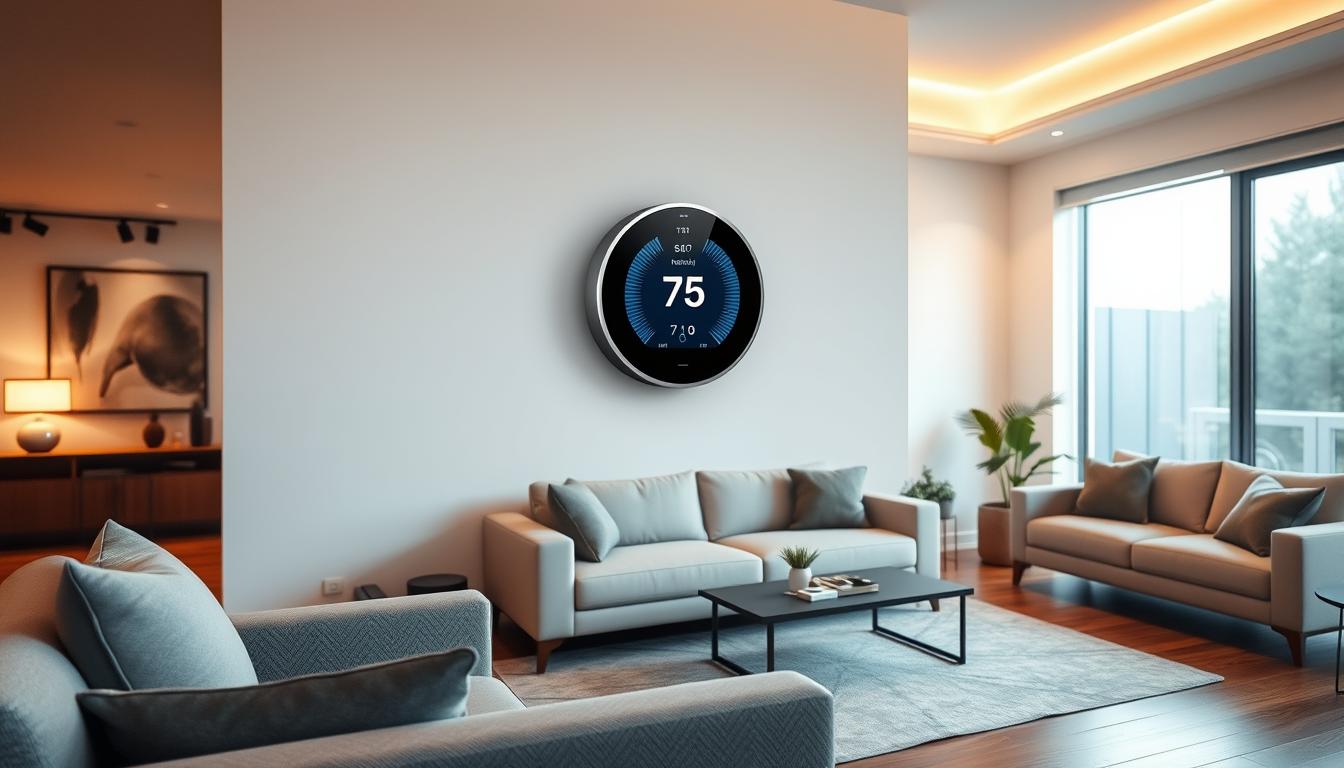As a homeowner, I’m always searching for ways to make my home more energy-efficient and cozy. That’s why I’m excited to share my guide on picking the best smart thermostats for your home. Smart thermostats are a great choice for saving energy, thanks to their advanced features like learning and remote access.
They can learn your schedule and preferences, helping you save energy and money. In this guide, we’ll look at the benefits of smart thermostats, important features to consider, and top brands. Whether you’re upgrading or installing a new one, this guide will help you choose the best smart thermostat for your home.
What Are Smart Thermostats?
Exploring smart thermostats is exciting. They learn your temperature likes and adjust it for you. You can control them from your phone, and some work with other smart home devices. This tech is part of HVAC automation, aiming to make our lives better and save energy.
Smart thermostats can be set to your schedule. This means you can save energy and money by setting different temperatures for different times. Plus, with a wifi thermostat, you can adjust your home’s temperature from anywhere.
Definition and Features
Smart thermostats have cool features, like:
- Learning capabilities: They get to know your temperature preferences and adjust it for you.
- Remote access: You can control your thermostat from your phone.
- Integration with other smart devices: Some models work with other smart home devices.
How They Work
Smart thermostats use smart algorithms to learn your temperature likes. They can be controlled from your phone, and some even work with other smart devices. Using a wifi thermostat lets you enjoy the latest in HVAC automation, making your life more comfortable and energy-efficient.
Benefits of Using Smart Thermostats
Exploring smart thermostats, I find they boost energy efficiency and cut costs. They learn my temperature likes and adjust it, saving energy and money.
Smart thermostats are great for managing home energy. They work with smart HVAC systems to make homes more energy-efficient. Some key benefits include:
- Energy Efficiency: They learn my schedule and preferences to save energy.
- Cost Savings: Lower energy use means lower bills.
- Enhanced Comfort: They keep the temperature just right, making my home more comfortable.
Using smart thermostats makes my home greener and more energy-smart. They work with smart HVAC systems to cut down on energy use and carbon emissions.
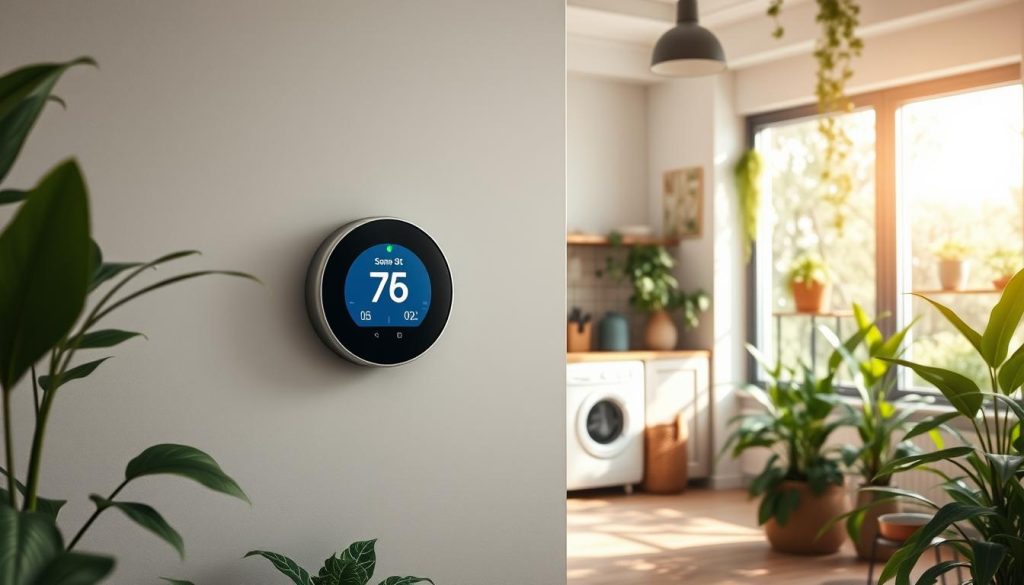
Key Features to Consider
When picking a smart thermostat, look for certain key features. These can make your smart thermostat better and help save energy. Important features include learning, remote access, and working with other smart devices.
Learning Capabilities
Smart thermostats that learn can adjust to your schedule and preferences. They automatically change the temperature to save energy and keep you comfortable.
Remote Access
Remote access is a big plus. It lets you control your thermostat from anywhere with your phone or tablet. This makes things easier and more flexible.
Compatibility with Other Devices
It’s also important for a smart thermostat to work with other smart devices. Choose ones that can connect with popular systems. This lets you manage everything from one place.
Some benefits of these features include:
- Enhanced convenience and control
- Increased energy efficiency
- Improved comfort and flexibility
By looking at these features, you can find a smart thermostat that fits your needs. It will make your home heating more comfortable and energy-saving.
| Feature | Benefit |
|---|---|
| Learning Capabilities | Optimizes energy-efficient home heating |
| Remote Access | Provides convenience and flexibility |
| Compatibility with Other Devices | Allows integration with popular smart home systems |
Top Smart Thermostat Brands
Choosing a smart thermostat can be tough with so many brands out there. As a homeowner, I look for the best value. I’ve checked out top brands, including those with wifi and programmable thermostats.
Well-known brands like Nest by Google, Ecobee, and Honeywell Home are popular. They offer features like energy savings and comfort. For instance, a wifi thermostat lets you control the temperature from anywhere.
Nest by Google
Nest by Google is a favorite among homeowners. They offer smart thermostats that work with a smartphone app. Their devices are easy to use and save energy, helping you cut down on bills.
Ecobee
Ecobee is known for its smart thermostats that fit with many smart home systems. Their thermostats let you customize your schedule. This way, you can set a routine that suits your family’s needs.
Honeywell Home
Honeywell Home is a trusted name with a variety of smart thermostats. They have wifi and programmable options. Their devices are simple to use and help you save on energy costs.
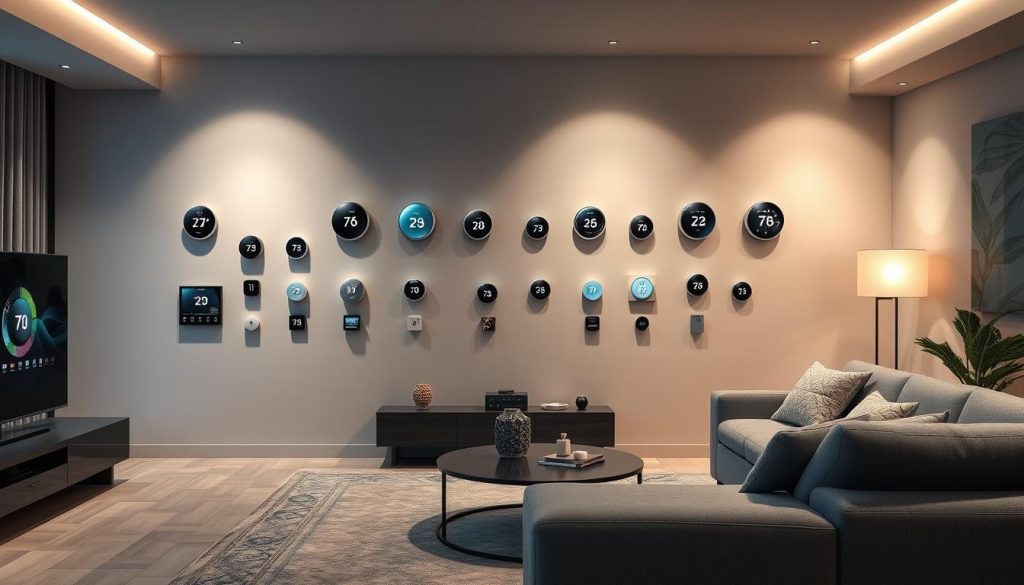
When picking a smart thermostat, think about compatibility, ease of use, and energy savings. By looking into the top brands, you can choose the best one for your home.
How to Choose the Right Smart Thermostat for Me
Choosing the right smart thermostat is key for your home. Smart home devices and HVAC automation are now common. They help manage your home’s energy better. I’ll help you pick the right one by looking at your home’s needs, budget, and installation options.
First, think about what your home needs. Look at its size, how many zones you need, and your heating and cooling system. This helps narrow down your choices. Smart thermostats like Nest and Ecobee offer cool features like learning and remote access.
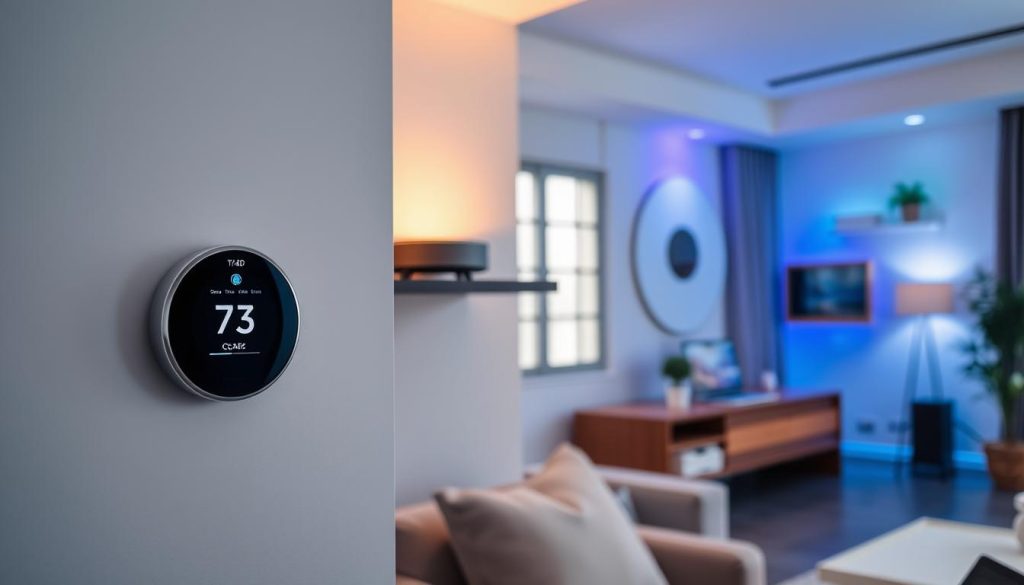
Then, decide how much you want to spend. Prices vary from under $100 to over $300. Think about the device cost and any installation fees. A smart thermostat can save you money and help the environment. Here are some budget tips:
- Device cost
- Installation fees
- Energy savings potential
Lastly, decide if you need a pro to install it. Some thermostats are easy to install yourself, but others need a pro. Remember to include installation costs in your budget. Look for local experts in HVAC and home energy systems.
Installation Options Available
Choosing your smart thermostat is just the first step. Next, you need to think about how to install it. This is key to making sure your energy-saving heating system works well. You have two main choices: DIY installation or getting professional help.
Installing smart thermostats can be easy if you know how. But, it’s important to think about the pros and cons of each choice. DIY might save money, but it takes more time and effort.
DIY Installation
Going for DIY installation? Make sure to follow the manufacturer’s guide closely. This helps avoid problems with your smart thermostat. DIY is cheaper and lets you work at your own speed.
Professional Installation Services
Professional installation, on the other hand, gives you peace of mind. It’s best if you’re not sure about installing it yourself or have a complex system. Experts can also make sure your system works its best.
Here’s a quick look at the two options:
- DIY installation: cost-effective, time-consuming, requires technical expertise
- Professional installation services: convenient, expensive, ensures correct installation
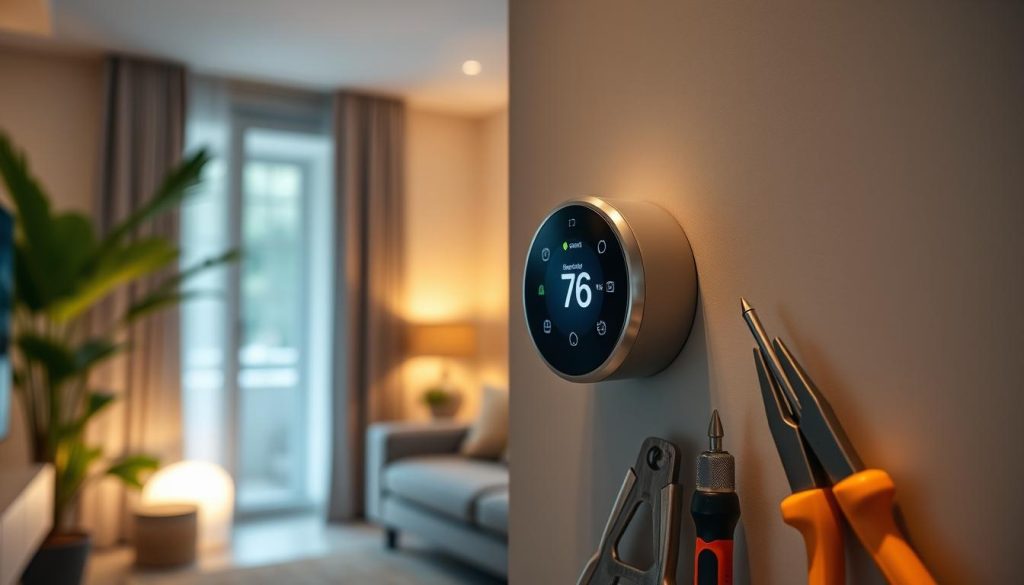
Choosing between DIY and professional installation depends on what you need. By considering these points, you can have a smooth installation. This will help you enjoy the energy-saving benefits of your smart thermostat and HVAC system.
Programming My Smart Thermostat
Exploring smart home devices, I see how crucial it is to program my wifi thermostat. A programmable thermostat lets me set a schedule that fits my life. This way, I save energy when I’m away.
To begin, I’ll make a schedule that changes the temperature at various times.
Some key features I’ll use are:
- Creating a schedule: This lets me set the temperature for different times, saving energy when I’m out.
- Using geofencing: My smartphone’s location helps adjust the temperature before I get home.
- Leveraging voice control: I can change the temperature with voice commands, making it easy to control.
Programming my smart thermostat unlocks its full potential. With a wifi thermostat, I can control my home’s temperature from anywhere. This makes my home comfortable and energy-efficient.
Overall, programming my smart thermostat is easy and effective. By setting a schedule, using geofencing, and voice control, I save money and energy. My home stays comfortable and efficient.
| Feature | Benefit |
|---|---|
| Creating a schedule | Saves energy when not home |
| Using geofencing | Adjusts temperature based on location |
| Leveraging voice control | Easy to control without physical interaction |
Understanding Energy Reports
To manage my home energy better, I look at the reports from my smart thermostat. These reports show how much energy I use and where I can cut back. This helps me make smart choices for my HVAC systems, saving energy and money.
The reports tell me about my daily and monthly energy use. They also compare it to past periods. This lets me see how I’m doing and make changes to use less energy. For example, I can set my thermostat lower when I’m not home or during peak hours.
Some key benefits of energy reports include:
- Identifying energy-wasting patterns and habits
- Optimizing my thermostat settings for maximum efficiency
- Reducing my utility bills through smart energy management
By using these reports and adjusting my HVAC systems, I can control my temperature better. This not only saves me money but also helps the planet. It’s a win-win for both my wallet and the environment.
Understanding energy reports is key to better home energy management. By using the data, I can make choices that save energy and help the planet. This makes my home more efficient and eco-friendly.
Troubleshooting Common Issues
Smart thermostats, like any device, can face common problems. My wifi thermostat sometimes loses connection, which is a hassle. Understanding the causes and fixes for these issues is key.
Smart thermostats might have issues with connectivity, temperature, or sensor problems. Regular upkeep and checks can help avoid these. Here are some common problems and how to fix them:
Connectivity Problems
- First, check your internet connection to make sure it’s stable.
- Try restarting your smart thermostat and router to fix connectivity issues.
- Move your thermostat closer to the router for a stronger signal.
Temperature Variations
Temperature issues can stem from the thermostat’s placement or faulty sensors. Place your thermostat in a central spot, away from sunlight and drafts. Also, inspect the sensors for damage or blockages.
Sensor Malfunctions
Dust or dirt on sensors can cause malfunctions. Clean the sensors and vents regularly. Also, check for software updates to keep your thermostat running well.
Maintenance Tips for Smart Thermostats
To keep my smart thermostat working well, I focus on regular maintenance. I check for software updates and clean the sensors and vents. This helps avoid problems that could affect my smart home devices.
Keeping my smart thermostat in good shape is key. I look for software updates on the manufacturer’s website. These updates often fix bugs and add new features.
Importance of Cleaning Sensors and Vents
Cleaning the sensors and vents is vital. Dust and debris can mess up temperature readings. Regular cleaning keeps my thermostat accurate and efficient.
Best Practices for Maintenance
- Check for software updates every 2-3 months
- Clean the sensors and vents every 6 months
- Inspect the device for any signs of wear or damage
By following these tips, my smart thermostat stays reliable and efficient. This is crucial for my smart home devices and energy management. Regular maintenance also saves me from costly repairs and saves time.
Future Trends in Smart Thermostats
The future ofsmart thermostatslooks bright, with a focus on connecting them to our homes. We’ll see smart thermostats working together with otherenergy-efficient home heatingand cooling systems. This will create a completesmart HVAC system that saves energy and keeps us comfortable.
Big changes are coming withartificial intelligence (AI)andmachine learning. Soon, thermostats will learn and adjust to our habits. They’ll even guess what we need, making our lives easier and more efficient.
As we all want to save money and help the planet, smart thermostats will play a big role. They’ll use data to find ways to save energy and cut down on waste. Homeowners will be able to control their energy use and help the environment.

